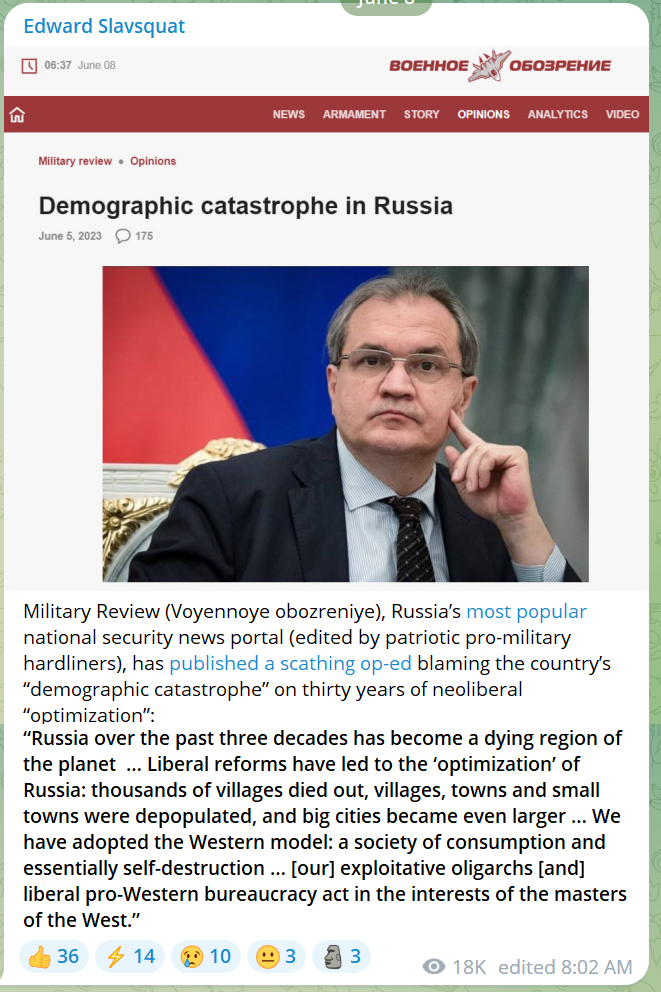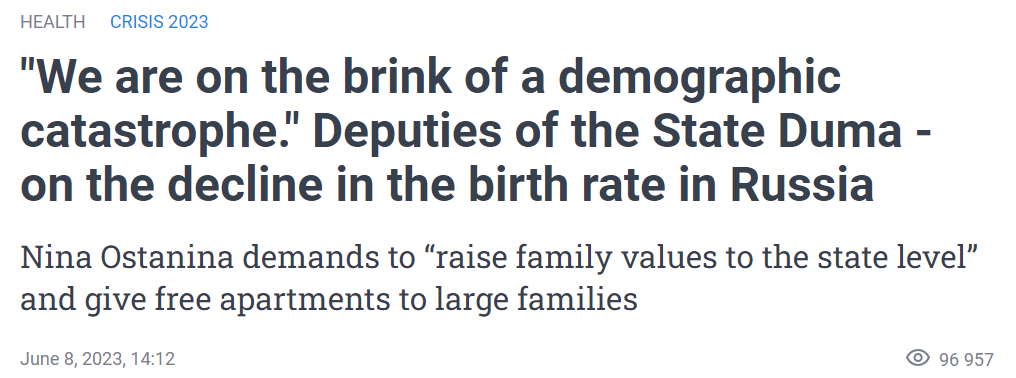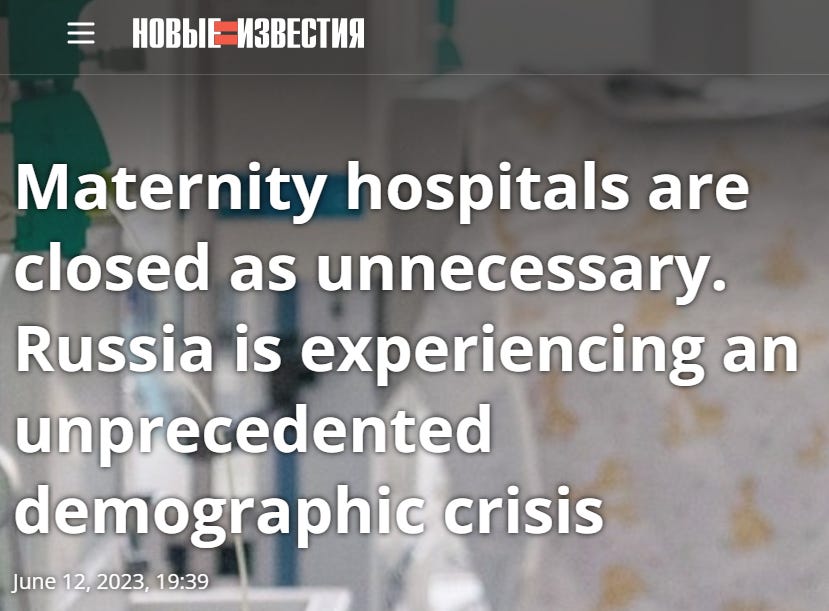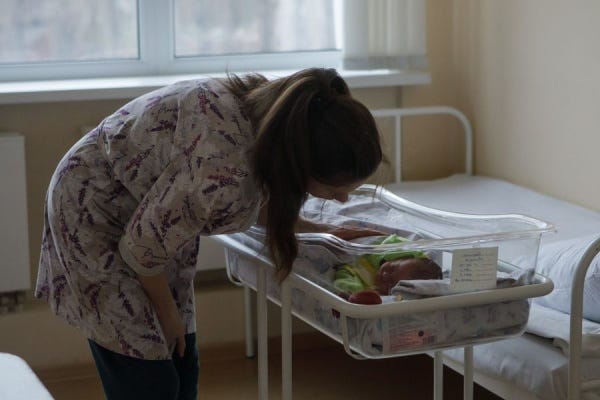Ignoring Russia's demographic crisis would be ill-advised
We're approaching the point of no return. Forceful measures are urgently needed
Russia’s demographic troubles pop up semi-regularly on this blog, most recently in May (“How deep is Russia's demographic hole?”).
I spend an obscene amount of time reading Russian media (I suppose someone has to?), and over the last several weeks, a clear trend has emerged: Every corner of Russian media is screaming about the country’s worsening demographic crisis.
The pro-military hardliners at Military Review, Russia’s business press, the “normie” publications—they’re all saying basically the same thing: This is a huge problem, the government is not doing enough to solve it, and if we don’t solve it soon, there will be catastrophic consequences.
Below is a chronology of recent news stories on this topic.
April 23
Business/finance outlet finam.ru highlighted the growing demographic crisis in an article published on April 23, and pointed to how this problem could affect Russia’s labor market:
The government cannot control the demographic crisis
The demographic crisis in Russia has been worrying experts for many years, and it has become especially acute in the last three years. However, during the pandemic, the most vulnerable social group to the disease was the elderly. In 2021, the statistical office recorded a record decline in pensioners—there were 200,000 fewer of them due to excess mortality.
In 2022-23, the decrease in the Russian population was significantly affected by migration, when young people of military age, the most economically active group, left the country.
At the same time, in 2023, the birth rate in Russia fell to its lowest level in the last 15 years—1.36 children per woman.
The Kremlin acknowledged the failure of the demographic policy despite maternity capital and targeted measures to support families with children.
“There are problems of an insurmountable nature, demographic pits that haunt us. This is the demographic hole associated with the Great Patriotic War, and the demographic hole associated with the nineties, when the country was collapsing and when the birth rate fell … We are living in a decade where these ‘holes’ have connected - this is the historical legacy that haunts us,” Kremlin spokesman Dmitry Peskov said.
He also added that new solutions are needed to bridge the demographic gap, which the government is looking for.
The labor market is losing young people and needs additional workers
The outflow of the able-bodied population and the consequences of the demographic hole of the 90s led to the fact that there is a shortage of personnel in the domestic labor market. Unemployment in the country is at a record low of 3.5%. The youth is especially missing.
According to a study by the consulting company FinExpertiza, by the end of 2022, the share of workers under 30 years of age in the country has dropped to a record low—they make up only 14.9% of the total number of employees and less than 11 million people. The number of employees aged 25 to 29 decreased most of all—by 724 thousand, to 7.2 million. The number of employees under 35 years old is below 22 million people. And the population continues to age.
Meanwhile, the Russian economy is in dire need of personnel. Thus, according to the Minister of Labor and Social Protection Anton Kotyakov, by 2030 it will need an additional 2.5 million workers. At the same time, 1.4 million people graduate from vocational schools every year.
The article also mentioned the government’s policy of providing financial assistance to new mothers, but argued this measure, for a variety of possible reasons, may now be “irrelevant”.

June 5
Military Review, Russia’s most popular national security news portal, published an op-ed on June 5 blaming the country’s “demographic catastrophe” on thirty years of neoliberal “optimization”:
Russia over the past three decades has become a dying region of the planet … Liberal reforms have led to the ‘optimization’ of Russia: thousands of villages died out, villages, towns and small towns were depopulated, and big cities became even larger. […]
We have adopted the Western model: a society of consumption and essentially self-destruction … [our] exploitative oligarchs [and] liberal pro-Western bureaucracy act in the interests of the masters of the West.
Let’s just say the author didn’t mince his words.

(By the way: If you haven’t joined the Edward Slavsquat Telegram Channel, you should! Because sometimes I post things there that I don’t cover or mention on The Blog.)
June 8
Russia’s demographic problems, and decreasing marriage and birth rates, were discussed at a conference in Moscow in early June. Outlet msk1.ru filed a report:
In Russia, the birth rate has significantly decreased and the number of cases of infertility has increased, said Irina Filatova, a member of the State Duma Committee for the Protection of Competition.
“Increasing the birth rate has been a state priority for Russia for many years,” she said at the OrgZdrav-2023 international congress, which is taking place in Moscow.
According to Filatova, socioeconomic factors influenced the situation.
“It’s quite bold to plan the birth of a child if there is no school, kindergarten, shop and clinic in the immediate vicinity,” the deputy noted.
“We are now on the verge of a demographic catastrophe,” she said, adding that young Russians have become much less likely to marry.
“According to Rosstat, in 2021 marriages fell 20% compared to 2010, and dropped by 40% compared to 1980. The concept of civil marriage in 2015 was supported by 29% of 100,000 respondents. In 2021, support for civil marriages jumped to 43%, and among young people under 24 years old—62%.”
“That is, two-thirds of our youth do not see the point in family and are not ready to take on such responsibility,” said Filatova.
According to the deputy, the medical factor also affects the birth rate.
“Given the growth of infertility statistics and the reduction in the number of women of childbearing age, it is necessary to provide medical care from the earliest childhood,” the deputy explained.
A week later, msk1.ru interviewed several doctors about the crisis—and their observations were rather alarming.

Very quickly, I want to highlight another quote from this conference (reported by Nakanune), also from Filatova:
I do not want to engage in open criticism, but I cannot agree with the thesis that we have a high availability of medical care. We have a problem [with accessibility to healthcare], and it is a colossal problem. As a person who constantly travels to the regions, I can say that it is almost impossible for residents to meet with specialists, including gynecologists.
In some cities there are mobile teams of medical specialists from large cities, but they come once a year, once every two years—there are such cases. In the Far East and the North, the situation is much worse. […]
If we talk about infertility statistics, then just over the past decade, female infertility has increased three times, male infertility has doubled only officially. I think this does not reflect the objective situation due to the under-examination of men.
This seems like a problem that definitely needs to be immediately remedied.
June 12
Novye Izvestia approached this topic from a slightly different angle: The drop in Russia’s birth rate has led to the closure of maternity wards, which will probably not help the situation:
In Russia, maternity hospitals began to close en masse. In the Kemerovo, Novosibirsk, and Rostov region. With a low birth rate, maintaining entire departments becomes unprofitable. In April, an anti-record was recorded—the lowest birth rate for Russia in the 21st century. […]
The birth rate is falling and the death rate is rising
In April 2023, 96.1 thousand children were born in Russia. Such indicators have not been seen since the 1990s … and April is not the only month when the number of newborns have fallen. From January to March, the birth rate fell by 2.9% compared to the first quarter of 2022. And in 2022, 1.306 million babies were born in the country—this is the worst figure since 2001.
The Russian authorities are concerned about the current situation. Deputy Minister of Labor and Social Protection Olga Batalina says that the poor age structure of the population is to blame, when the number of women of childbearing age is declining due to the demographic hole of the 90s.
The state is trying with the help of money to make childbirth attractive to women. For this, maternity capital was introduced in 2007. This helped until 2020, and then it stopped working. After maternity capital began to operate even with one child, the number of second children decreased. Over the past 6 years, the birth rate of first children has decreased by 19.9%, and the second—by almost a third, or 31%.
As a result, in 2022, the death rate exceeded the birth rate by one and a half times. In Russia, 1.306 million people were born and 1.905 million people died. The mortality rate in 2022 is worse than [the first year of the] pandemic, 2020.
The article noted that mobilization, and casualties from the SMO, will undoubtedly exacerbate the problem—and the resulting impact has not yet been “officially” recorded.

On June 12, Nakanune published comments from Vadim Bezverbny, Deputy Director of the Institute for Demographic Research, part of the Federal Scientific Research Center of the Russian Academy of Sciences.
Bezverbny warned that the crisis facing Russia was of an existential nature, and proposed expanding state support measures:
In our country, even many economists do not understand the role of demography, the role of the population in the life of society and in the development of the state. What is a population? This is the volume of the market, these are consumers, taxpayers, those liable for military service, about whom we are talking a lot now … Demography determines the main vector of the socio-economic and even political development of the state. […]
We need a systematic approach [to the problem], in addition to housing policy, in addition to supporting families with children, including material support, which in our case boils down more to social policy. We need to separate the demographic and social spheres. We support a wide coverage of low-income families based on the criterion of need, but at the same time we leave out large categories of the population who may have an average income slightly above the minimum threshold, but they are no longer eligible for state support. And demographic policy is a policy specifically to increase the birth rate, and not the fight against poverty.
June 13
This one is cute. Russian media reported the comments of a WHO “reproductive health expert”, who predicted Russia’s demographic crisis could last until (wait for it) 2030:
Obstetrician-gynecologist, WHO reproductive health expert Lyubov Erofeeva said that the demographic crisis in Russia, caused by low birth rates and the difficult situation of the 90s and early 2000s, will last 5-7 years.
It’s always reassuring when the WHO prophesizes that your birth rate could have “difficulties” until 2030, a year that has no special meaning or significance for the globalist, UN-led agenda.

And these are just the stories I randomly stumbled across while browsing Russian media. I am certain there many more from the last 30 days. Maybe there’s even something from today. But we can save them for another time.
Well … what’s to be done? I hope the relevant authorities are taking this issue—and I cannot think of a more critical issue to Russia’s long-term survival as a nation—very seriously.
If you found this blog post informative, consider tossing Edward Slavsquat a few rubles. Right now you can acquire a 12-month sub for the low price of $38! That’s barely a taco dinner with a few margaritas. What a steal!





And obviously, not a single word about poisonous clot shots and murderous c19 hospital protocols! I personally knew a healthy and fit 73-year-old man who was put on a ventilator and died in 2020. And I've heard of 6 jab-related deaths and at least 15 cases of health decline in my social circle (I don't live in Russia so this circle is not very large).
It's not a problem. They can just replace old whitey with third world savages like they are doing in my country and Sweden and Ireland etcetera and if you turn a blind eye to the rapes and brutal murders they commit then all is good. Fekking tragic.